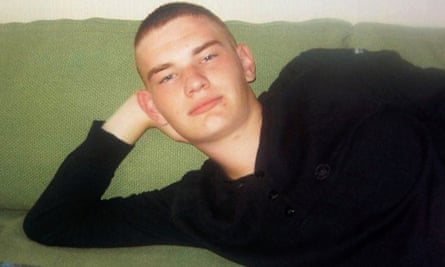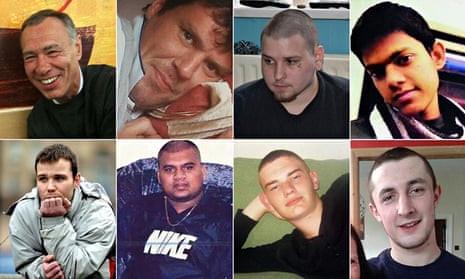The human toll of the crisis gripping prisons in England and Wales is exposed with new figures obtained by the Guardian revealing that 125 prisoners have killed themselves in 20 months – an average of more than six a month.
For the first time the Guardian has identified the individuals behind the statistics that show suicide is at its highest rate in prisons for nine years, and there is no sign that the scale of the tragedy is being checked.
The investigation, which examined all suicides between January 2013 and 28 August 2014, found four women and 121 men, aged between 18 and 74, killed themselves in the adult prison system.
Since then and up to 2 October another nine men, aged between 21 and 46, killed themselves, bringing the total number of self-inflicted deaths since January 2013 to 134. Three people killed themselves on one day, 1 September 2014.
The Prison Service ombudsman, Nigel Newcomen, described the deaths as “utterly unacceptable” in a modern age and said they reflected the “rising tide of despair” across the prison system. He said his recommendations to save future lives were being ignored.
“There is no question the Prison Service is more challenged now than [it has been] in a generation,” Newcomen said. “My job is to draw lessons from these individual human tragedies and I don’t think that adequate heed has been taken of them.”
He said the “appalling upsurge in suicides” meant there was a need to review the approach within prisons, including “more resources being applied”.
The Guardian looked at every case of suicide in the prison system over the 20-month period. Included among them are:
A 22-year-old first-time offender who killed himself within eight hours of being locked up on remand. He told guards he was feeling suicidal but no care plan was initiated.
A 31-year-old who killed himself while on remand for stealing a T-shirt from TK Maxx. He had warned officers he was going to hang himself and an inquest concluded that the Prison Service failed to take reasonable steps to prevent his death.
A 21-year-old with no criminal record and a serious mental health problem who killed himself after being sent to prison “for his own safety”.
A 55-year-old man in the 18th year of an indeterminate life sentence with a recommendation that he serve a minimum of seven years. He killed himself after being moved without explanation from an open prison to segregation in a closed establishment.
More than a quarter of those who died, 26%, were on remand awaiting trial. Remand prisoners awaiting trial make up just 10% of the total prison population. Young men were found to be most at risk.
Chris Grayling, the justice secretary, has repeatedly claimed that there is no pattern to the rise in suicides in the last 20 months. But the Guardian has identified distinct themes in many of the deaths, after examining reports from inquests, speaking to family lawyers and relatives, and analysing the investigations by the Prison Service ombudsman.
These include: failures in the assessment of risk in the face of obvious warning signs, lack of training for prison staff, inadequate monitoring once risk was identified, and insufficient communication with families, particularly in the case of vulnerable young inmates. Many of those who took their own lives had mental health problems.
Lynda Davison’s 21-year-old son, Steven, hanged himself in HMP Glen Parva, in Leicestershire. He had been sent there “for his own safety” after attempting to cut his throat.
She said: “I didn’t expect them to love him, but I did think they would look after him until he came home to get proper treatment.”
The president of the Prison Governors Association, Eoin McLennan-Murray, said governors felt it was not a coincidence that the peak in suicides was happening when the service was facing its greatest financial challenges for 30 years.
“There are staff shortages across the estate, prisoners are locked up more, they don’t get to activities, they don’t engage with a constructive regime. Staff have less time to interact with them, things are missed,” he said. “Staff are human, they are under extreme pressure, the service is under extreme pressure, and sometimes there are tragic consequences.”
In the 20-month period, the figures show that Woodhill, Wormwood Scrubs and Hewell prisons had the highest number of self-inflicted deaths, with five each. Bullingdon, Ranby, Durham, Leeds, Birmingham, Dovegate and Chelmsford all had four self-inflicted deaths.
Several families of those who have died are suing the Ministry of Justice, alleging that its failure to act is a breach of its obligations under article 2 of the Human Rights Act to safeguard lives.
Chris Topping, from Jackson Canter solicitors, is suing the MoJ and prisons contractor G4S on behalf of the families of four men who killed themselves. He said: “There are different triggers to each death but the common themes are that there is often a cavalier attitude to the need to provide a consistent level of mental health care.
“Prisons are clearly no place for those who suffer from any sort of mental health issue. Staff are inadequately trained. There seems to be a lack of compassion within the system … where systems do exist it is a matter of chance as to whether they work.”
Patricia Jarman, whose son Kevin Scarlett, 30, had serious mental health problems and hanged himself in HMP Woodhill, Buckinghamshire, after serious failings in his care, said the government needed to be made accountable.
“It feels like Kevin was seen as a statistic, a faceless individual, another difficult person who could not be helped. The Prison Service has our loved ones and they don’t know how to cope with them, they are not trained properly to deal with mental health and they haven’t got the staff to cope.”
The rising level of self-inflicted deaths comes amid an increase in violence across the prison estate and a reduction in staffing levels of up to 40% in some institutions, according to figures from the Howard League for Penal Reform.
Self-harm has increased by 26% between 2009-13 to 17,213 incidents; violence against prison officers has risen by 45% from 2010-13, and there has been a 72% increase in the number of times specialist squads have been called to deal with prison riots since 2010.
Earlier this month a riot broke out at Swaleside prison on the Isle of Sheppey – where an inspection recently revealed staff shortages were affecting every aspect of the prison – and an officer was stabbed in the head before a Home Office Tornado riot unit brought the situation under control.
While the government insists staff shortages are not affecting the level of suicides, some cases examined by the Guardian show this factor could be one key to the failure to protect vulnerable prisoners.
At the inquest last month into the self-inflicted death of the Sri Lankan refugee Satheeshkumar Mahathevan at HMP Pentonville, a prison governor said that because of cuts there were now not enough staff to assign a personal officer to every prisoner to look after their welfare.
Deborah Coles of Inquest said: “Behind the statistics are stories of preventable tragedies. The indifference and complacency of the justice secretary to this issue is deeply insensitive to those families whose highly vulnerable relatives have been failed by criminal justice policies that imprison them in institutions ill-equipped and ill-resourced to keep them safe.”
The prisons minister Andrew Selous said reducing the prison suicide rate was a key priority.
“We are working hard to understand the reasons for the recent rise, but there is no simple explanation. As is the case in society, the reasons behind any suicide are complex and individual.
“Young adults are a particularly challenging and vulnerable group, and that is why we have commissioned an independent review into the deaths of 18- to 24-year-olds in prison custody.
“The vast majority of recommendations from the prisons and probation ombudsman and HM Inspectorate of Prisons are accepted and action is taken to address them. We also take very seriously the concerns raised by coroners and take action where appropriate.”
‘He said: “Bye bye, I love you”, and that was it’

With a history of acute mental health problems, the 21-year-old was jailed “for his own safety” after attempts to find him a secure mental health bed failed. He had no criminal record, and was charged with possession of an offensive weapon after he tried to cut his own throat.
The serious personality disorder which affected Steven flickered into his parents’ consciousness when he became gripped by paranoia at the age of 10. In his mid-teens, the voices in his head became relentless and powerful, and led to multiple incidents of self-harm, said Lynda and Jeff Davison, who live in Loughborough.
“He called them the devil and his disciples,” his father said. “They told him to do things. He started to medicate himself with whatever he could get his hands on to get rid of the voices. Steven used to ask for help; he wanted help. The mental health crisis team would come out one day, but not the next. There was no consistency, no treatment, no support.”
Steven, who was dyslexic and left school at 16 unable to read or write, was well known to the local police because of his history of self-harm. But last year he was charged with possession of an offensive weapon when he tried to cut his throat – something which threw him into the criminal justice system. When no secure bed was available, a judge remanded Steven to HMP Glen Parva until a specialist facility could be found.
“He told him: ‘You’re not a criminal, you are not going to go down the bad route. You are going to go down the mental health route,” his father said.
Despite his history, Steven was assessed as being of low risk on arrival at the prison. In the final weeks of his life he harmed himself twice – on one occasion carving words into his legs, and the other time trying to set alight his arms. He also received a call from his girlfriend who told him that his grandfather had died and that she was leaving him. Yet he remained assessed as low-risk.
The prison made no attempt to communicate with the family as his mental health deteriorated.

“We could have told them how at risk he was,” his mother said. “I didn’t expect them to love him but I did think they would look after him until he came home and could start his treatment.”
On the afternoon of 29 September last year, Lynda was out buying bedroom furniture for her son’s return when he phoned her. “He just seemed really down,” she said. “I told him I was coming to see him on Monday, I asked him if he needed any money. He kept saying: ‘No, I’ll be all right, I am coming home’. Then he said: ‘Bye, bye, I love you’, and that was it.”
An hour later, his mother received another call telling her to go to Leicester hospital where Steven was being admitted to intensive care. She did not make it in time. “A nurse rang as I was on my way and said: ‘I’m so sorry, we have just lost him.’”
At his inquest last month, the jury concluded that Steven’s individual needs, risks and vulnerabilities had not been appropriately understood, assessed or recorded in Glen Parva (where eight young men have killed themselves in four years), that he was not assessed by a suitably qualified mental health doctor, and that he should have been transferred to a safe cell with no ligature points.
Jeff confronted the governor, Alison Clark, afterwards. “She was saying sorry to me. I just told her: ‘Don’t be sorry. Do something.’ That’s when she started crying and told me: ‘I’m trying, I’m really trying.’”










